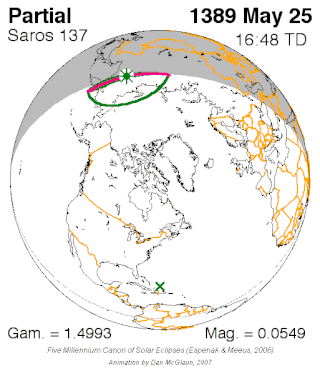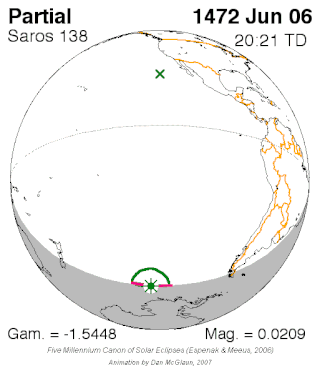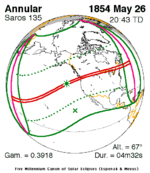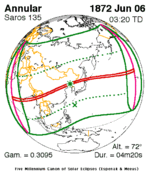
Saros cycle series 111 for solar eclipses occurred at the Moon's ascending node, repeating every 18 years and 11 days, containing 79 eclipses, 42 of which were umbral. The first eclipse was on 30 August 528 and the last was on 5 Jan 1935. The longest totality was 6 minutes 11 seconds on 9 June 1592 and the longest annular eclipse was 3 minutes 4 seconds on 15 April 907.

Saros cycle series 114 for solar eclipses occurred at the Moon's descending node, repeating every 18 years, 11 days, containing 72 eclipses, 46 of which were umbral. The first eclipse was on 23 July 651 and the last was on 12 September 1931. The longest totality was 4 minutes 18 seconds on 21 April 1697, the longest annular was 4 minutes 33 seconds on 13 February 994.

Saros cycle series 115 for solar eclipses occurred at the Moon's ascending node, repeating every 18 years, 11 days, containing 72 eclipses, 55 of which were umbral. The first eclipse was on 21 June 662 and the last was on 12 August 1942. The longest totality was 6 minutes 24 seconds on 5 July 1293, the longest annular was 1 minute 54 seconds on 27 May 1816.

Saros cycle series 117 for solar eclipses occurs at the Moon's ascending node, repeating every 18 years, 11 days, containing 71 eclipses, including 56 umbral eclipses. The first eclipse in this series was on June 24, 792 AD. The final eclipse in this series will be on August 3, 2054. The most recent eclipse was a partial eclipse on 13 July 2018 and the next one will be a partial eclipse on 23 July 2036.

Saros cycle series 121 for solar eclipses occurs at the Moon's ascending node, repeating every 18 years, 11 days, containing 71 eclipses. 55 of these are umbral eclipses. The first eclipse in the series was on 25 April 944 and the last will be on 7 June 2206. The most recent eclipse was an annular eclipse on 7 February 2008 and the next will be an annular eclipse on 17 February 2026.

Saros cycle series 122 for solar eclipses occurs at the Moon's descending node, repeating every 18 years, 11 days, containing 70 eclipses, 42 of which are umbral. The first eclipse was on 17 April 991 and the last will be on 17 May 2235. The most recent eclipse was a partial eclipse on 6 January 2019 and the next will be a partial eclipse on 16 January 2037.

Saros cycle series 123 for solar eclipses occurs at the Moon's ascending node, repeating every 18 years, 11 days, containing 70 eclipses, 44 of which are umbral. The first eclipse in the series was on 29 April 1074 and the last will be on 31 May 2318. The most recent eclipse was a partial eclipse on 25 November 2011 and the next will be a partial eclipse on 5 December 2029.

Saros cycle series 126 for solar eclipses occurs at the Moon's descending node, repeating every 18 years and 11 days, containing 72 eclipses, 41 of which are umbral. The first eclipse was on 10 March 1179 and the last will be on 3 May 2459, lasting 1,280 years. The most recent eclipse was a total eclipse on 1 August 2008 and the next will be a total eclipse on 12 August 2026.

Saros cycle series 128 for solar eclipses occurs at the Moon's descending node, repeating every 18 years, 11 days, containing 73 eclipses, 40 of which are umbral. The first eclipse in the series was on 29 August 984 and the last will be on 1 November 2282. The most recent eclipse was an annular eclipse on 20 May 2012 and the next will be an annular eclipse on 1 June 2030.

Saros cycle series 129 for solar eclipses occurs at the Moon's ascending node, repeating every 18 years, 11 days, containing 80 eclipses, 41 of which are umbral. The first eclipse in the series was on 3 October 1103 and the last will be on 21 February 2528. The most recent eclipse was a hybrid eclipse on 20 April 2023 and the next will be a total eclipse on 30 April 2041.

Saros cycle series 131 for solar eclipses occurs at the Moon's ascending node, repeating every 18 years, 11 days, containing 70 eclipses, 41 of which are umbral. The first eclipse in the series was on 1 August 1125 and the last will be on 2 September 2369. The most recent eclipse was an annular eclipse on 26 January 2009 and the next eclipse will be an annular eclipse on 6 February 2027.

Saros cycle series 132 for solar eclipses occurs at the Moon's descending node, repeating every 18 years, 11 days, containing 71 eclipses, 42 of which are umbral. The first eclipse in the series was on 13 August 1208 and the last eclipse will be on 25 September 2470. The most recent eclipse was an annular eclipse on 26 December 2019 and the next will be an annular eclipse on 5 January 2038.

Saros cycle series 133 for solar eclipses occurs at the Moon's ascending node, repeating every 18 years, 11 days, containing 72 eclipses, 53 of which are umbral. The first eclipse in the series was on 13 July 1219 and the last will be on 5 September 2499. The most recent eclipse was a total eclipse on 13 November 2012 and the next will be a total eclipse on 25 November 2030.

Saros cycle series 136 for solar eclipses occurs at the Moon's descending node, repeating every 18 years, 11 days, containing 71 eclipses, 56 of which are umbral. The first eclipse in the series was on 14 June 1360 and the last will be on 30 July 2622. The most recent eclipse was a total eclipse on 22 July 2009 and the next will be a total eclipse on 2 August 2027.

Saros cycle series 137 for solar eclipses occurs at the Moon's ascending node. It repeats every 18 years, 11 days, and contains 70 eclipses, 55 of which are umbral eclipses. The first eclipse in the series was on 25 May 1389 and the last will be on 28 June 2633. The most recent eclipse was an annular eclipse on 21 June 2020 and the next will be an annular eclipse on 2 July 2038. The longest duration of totality was 2 minutes, 55 seconds on September 10, 1569 and the longest annular eclipse will be 7 minutes 5 seconds on 28 February 2435. This series has an unusual order of umbral eclipses, with 10 total eclipses followed by 6 hybrid eclipses, 4 annular eclipses, 3 more hybrid eclipses, and then finally 32 annular eclipses.

Saros cycle series 138 for solar eclipses occurs at the Moon's descending node, repeating every 18 years, 11 days, containing 70 eclipses, 54 of which are umbral. The first eclipse of the series was on 6 June 1472 and the last will be on 11 July 2716. The most recent eclipse was an annular eclipse on 10 May 2013 and the next will be an annular eclipse on 21 May 2031.

Saros cycle series 140 for solar eclipses occurs at the Moon's descending node, repeating every 18 years, 11 days, containing 71 eclipses, including 47 umbral eclipses. The first eclipse in this series was on 16 April 1512 and the last will be on 1 June 2774. The most recent eclipse was an annular eclipse on 26 February 2017 and the next will be an annular eclipse on 9 March 2035.

Saros cycle series 141 for solar eclipses occurs at the Moon's ascending node, repeats every 18 years, 11 days containing 70 eclipses, 41 of which are umbral. The first eclipse in this series was on 19 May 1613 and the last will be on 23 June 2857. The most recent eclipse was an annular eclipse on 15 January 2010 and the next will be an annular eclipse on 26 January 2028. This series contains only annular eclipses from 4 August 1739 through 14 October 2460, with no total or hybrid eclipses.

Saros cycle series 146 for solar eclipses occurs at the Moon's descending node, repeating every 18 years, 11 days, containing 76 eclipses, 41 of which are umbral. The first eclipse of the series was on 19 September 1541 and the last will be on 29 December 2893. The most recent eclipse was a total eclipse on 11 July 2010 and the next will be a total eclipse on 22 July 2028.

An annular solar eclipse occurred on May 9, 1948. A solar eclipse occurs when the Moon passes between Earth and the Sun, thereby totally or partly obscuring the image of the Sun for a viewer on Earth. An annular solar eclipse occurs when the Moon's apparent diameter is smaller than the Sun's, blocking most of the Sun's light and causing the Sun to look like an annulus (ring). An annular eclipse appears as a partial eclipse over a region of the Earth thousands of kilometres wide. Annularity was visible from Car Nicobar, the northernmost of the Nicobar Islands, and Burma, Thailand including Bangkok, French Indochina, North Vietnam, China, South Korea, Rebun Island in Japan, Kuril Islands in the Soviet Union on May 9, and Alaska on May 8. It was the first central solar eclipse visible from Bangkok from 1948 to 1958, where it is rare for a large city to witness 4 central solar eclipses in 10 years. The moon's apparent diameter was only 0.006% smaller than the Sun's, so this was an annular solar eclipse that occurred on May 9, 1948. Occurring 7.1 days after apogee and 6.6 days before perigee, the Moon's apparent diameter was near the average diameter.










































